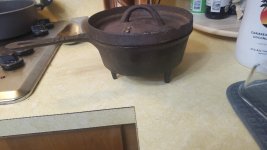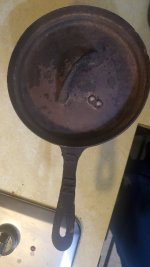-
If a web search for the answer to your cast iron cookware question has brought you directly to this forum, the information you seek may be covered in one of the many reference topics featured on the main website.
Quick Links: · Main Website · How to Identify Unmarked Pans · All About Cleaning & Seasoning · Reproductions & Counterfeits · Commonly-Used Terms
You are using an out of date browser. It may not display this or other websites correctly.
You should upgrade or use an alternative browser.
You should upgrade or use an alternative browser.
Help identifying camp skillet
- Thread starter CBordelon
- Start date
The raised markings on the cover and handle are similar to the way some known manufacturers marked theirs, but the gate marks aren't consistent with those makers. Is it an unknown maker's original or copies cast using obsolete casting technology is the question.
Bruce Lockhart
Member
If it is an heirloom handed down that many times, sounds like it could fit into the time period when gate marks were the norm. Tracking down which ancestor first got it and where they lived at the time might give you an idea of who made it. If you are really curious, an ancestry search might be in order.
Johan Maree
New member
I found images of skillets similar in design and markings posted on the internet. The name attached to them is BALTO - Baltimore Iron Works. But there seem to be many variations in the way these vessels were marked. Some have gate marks on both the lid and the skillet, others only have a gate mark on the lid. Some have "BALTO" marked on the lid, others do not. And although the handles are not all marked in exactly the same fashion, their design matches.
Bruce Lockhart
Member
I was looking through the foundry database and saw a picture of a pot with a strikingly similar handle made by Blacklock. The lid is different, but it's a bigger pot. As Doug pointed out, could be an under-capitalized foundry, but it could be a Blacklock. Wouldn't that be interesting. What do the rest of you think?
The "double hinged finger" technology was the first to replace embedding a pre-cast piece in a sand mold to achieve a continuous loop handle. It was embraced by most every maker until the single finger style we see on most 20th century covers came into use. The fact that the hinged piece(s) must be tapered in order to extract the pattern from the sand mold without damaging it means the handles they create all look substantially alike.
Bruce Lockhart
Member
I'm confused. I'm new at this, so I'm not familiar with the technology terms. I was referring to the pot, not the lid. The handle is flat on top and has a number, and the IN (I assume that means inch) looks the same. How the foundries put the handles on the lids has always been a mystery to me. Now, thinking about it, I'm not even sure how they attach the handles to the pot. I just assumed they were poured with the body of the pot. This post has definitely opened a big blank spot in my knowledge of cast iron production. My lesson for today is how much I don't know.
Sorry for the confusion; about the only things ever seen actually marked Blacklock are flanged oven lids; the casting technology referred to pertains only to the cover handle. Camp skillets with flat-topped handles are pretty common across makers, as are the raised dimensional markings on them. Camp skillet handles are a fixed part of the entire pot pattern.
Bruce Lockhart
Member
O.K. After thinking about the "double hinged technology", lid handles, and molds for a while, I think I figured that out. One small step. As always, thanks for patiently sharing your knowledge with us who are new to cast iron collecting and using. We really appreciate the help.



